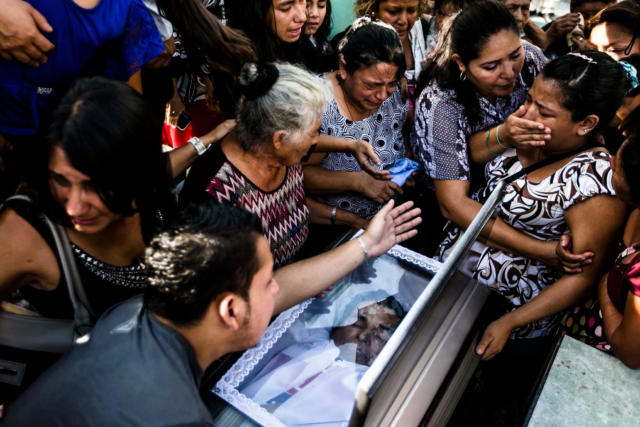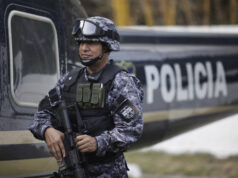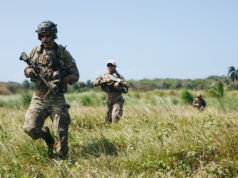
It was January 5, 2020, a new year, but it had brought the same old killings in a city dogged by violence, where the fight for space in competing illicit economies is often a deadly affair.
For San Salvador resident Humberto Reyes, a sunny morning in the Historic Center’s sprawling markets began with two shots in the back of the head. His death, police suspected, was likely the result of intra-gang squabbles in the area.
San Salvador has always been one of the most violent municipalities in a country among the deadliest in Latin America. The Central Market is one of the most violent places in the most violent city in one of the most violent countries in Latin America, even after the coronavirus slowed much of the commercial activity in the area.
Historic Center: A Lucrative ‘Protection Racket’
The Historic Center – which one police intelligence official described as “organized disorder” – is the heart of the country’s capital city, San Salvador. It combines the chaos that comes with being the headquarters of government and the single largest, open-air market. On any given pre-COVID-19 weekday, buses and cars of all sizes packed the streets. Sidewalks were crowded with hundreds of informal vendors, and tourists would amble past colonial-era buildings and religious sites.
San Salvador’s Central Market lies a few blocks southwest of the Historic Center’s main squares.
The complex comprises about a dozen buildings, chock-full of stores and restaurants, adorned with multicolored hoardings, fluorescent lights, plastic furniture, and hawkers selling fresh food, clothes, and electronics. There are an estimated 5,500 to 6,000 stands in the Central Market. On an average day stalls swarmed with city residents who rely on the city’s thriving commerce for work and access to affordable goods.
The Central Market is the Historic Center’s wholesale hub for both legal and illegal goods, according to police intelligence. It has long been dominated by powerful contraband distribution networks that traditionally paid for protection from a mixture of private and public security forces. But that system has been steadily, often violently, usurped by street gangs trying to take over what is often referred to as a “protection racket” – extortion – as well as trying to become wholesalers themselves.
The protection racket in the Historic Center as a whole is mostly run by two of the country’s most notorious street gangs – the Mara Salvatrucha (MS13) and a faction of the Barrio 18 known as the Revolucionarios (Revolutionaries) – both of which emerged in El Salvador in the 1990s following the mass deportation of gang members from the United States.
They set up protection rackets throughout the Historic Center. The biggest revenue stream for gangs are the payments that come from the informal market in the area. Roughly speaking, the gangs collect $1 per weekday from each of the 40,000 vendors that operate without a license in the area, or about $1 million per year, according to interviews with vendors and authorities.
In return, the gangs have established a fierce regime that prohibits theft and other crime, but this complicated quid pro quo rarely falls in the vendors’ favor.
There are also a wide variety of legitimate storefronts in the Historic Center that pay an equally wide range of rents.
Some pay weekly, some monthly. All of them pay one-time fees during Christmas, Easter, and the annual August Festival. They are sometimes asked to “collaborate” when gang members are hospitalized or killed (to indemnify gang members’ wives or girlfriends), or when there are unexpected legal fees or other unforeseen expenses.
Taxi drivers also pay on average $1 per day, so they can park and work from specific points in the Historic Center. Some pay a weekly instead of a daily fee. Some non-taxi drivers have said the gangs established a means to calculate fees based on “commercial flow” (how many rides, or “giros,” any single taxi driver did), but no taxi drivers appear to confirm that.
Gangs also feed on the buses and transport companies that pass through the Historic Center according to the number of buses they own and operate, and that cost can reach into the thousands of dollars per month. Distribution companies allegedly pay per truck.
The Battle for the Central Market
Always on the lookout for new ways to expand their criminal earnings, the gangs have made a conscious decision to take over at least part of the protection racket in the Central Market, according to police sources in the area. This decision put them in direct conflict with another, well-armed group: private security guards hired by market workers to fend off criminal groups like the gangs.
These guards have long had their own protection racket, getting money not just from the formal and informal vendors, but also the contraband distributors who are frequently harassed by gangs. Local police estimate that each market stall pays a weekly fee of around $15 to $20, meaning the extraction of rent from the market stalls alone could be worth between $82,500 and $120,000 a week for whoever controls it.
But whom to pay? In the early part of the 2000s, the gangs and the guards maintained a complicated détente. It did not last.
On one side was the Barrio 18 Revolucionarios, who controlled about half of the market and had forged an alliance with one of the main companies in the city center to collect protection money together.
On the other side was the MS13, which did not want to forge an alliance with private security as much as take over their spots or use private security for their own ends. In other parts of the Historic Center, for instance, the MS13 reportedly used private security to collect extortion for them. And, according to an indictment against numerous leaders of MS13, the gang used its contacts with a private security guard in the city center to purchase police-issued flak jackets and other police-issued clothing to camouflage themselves during high-level operations.
Not surprisingly, the violence deepened. In 2015, there were a record 29 killings around the Central Market, according to forensic medicine homicide data. The violence has subsided somewhat since, but the fight over the protection racket and the wholesale market are still ongoing.
The Revolucionarios continue to employ the strategy of aligning with the umbrella organization that represents private security guards operating in the Central Market. Called AVIMCES, it is an attractive ally, since it not only manages large swathes of the protection racket – and shares its revenue – but also holds the keys to the market and controls specific commercial spaces critical to criminal activities, including drop-off points for contraband and stolen goods.
The benefits for private security forces are less clear. According to the police, the pact is informal and based more on their mutual enmity with the MS13 than the guards’ sympathy with the Barrio 18. What’s more, being associated with the gangs has landed security guards in hot water. Still, according to police and businesses operating in the area, the two maintained this informal pact through at least the beginning of 2019.
Gang Violence and Control in the Historic Center
The fighting between the gangs and the guards accounts for only some of the homicides but making sense of all the gang violence in the area is difficult. There are multiple reasons for the gangs to commit homicides, especially in downtown San Salvador’s most vibrant marketplace. But most of them are related to efforts to establish a protection racket.
First, in the case of the Central Market, violence allows the gangs to expand their principal revenue source: extortion. This holds true throughout the Historic Center, where gangs are absorbed in near-perpetual conflicts for control of vending hubs, drug peddling hotspots, and contraband and counterfeit sales points. In these spaces they are either collecting extortion payments or they are managing the businesses themselves.
The boundaries between gang territories, however, are porous and fluid. Take the case of extortion payments. Gangs may leave phones, which will serve for short periods as the means by which the two parties will communicate. But for payments, the gangs have to go in person, exposing themselves. Gang members will arrive in groups of two to four members on the same day every week. Two will wait on the outside of the storefront keeping watch, while the others will enter and collect the money. The collectors will then leave the store and quickly deposit the money at a street vendor’s stall, so as to avoid being captured with marked money and to avoid any kind of ambush from a rival.
The number of parties involved in the regular collection of extortion creates a volatile situation. The practice involves several layers of the gangs, as well as civilians who keep watch or transfer money for them. There may be fatal misunderstandings if distributors and vendors operating inside and outside the market do not know who controls what territory. And those payment systems may change as competition gets more intense. In the process, money may go missing or get stolen. And other criminal actors may step into the confusion to take advantage, causing further misunderstandings. The result, very often, is violence.
Second, gangs commit homicides to maintain or expand their criminal portfolios.
As noted, the gangs are trying to enter the wholesale market for contraband and counterfeit products that operates in and around the Central Market. Controlling the distribution of these products to thousands of informal vendors would translate into a colossal cash boost that could serve for buying firearms, drugs, and other illicit products to consume and sell.
Third, gangs commit homicides to maintain political and social control in their areas of influence. The gangs impose strict rules on their own members and those who operate in their territory. Suspected collaboration with security forces is the most commonly perceived offense but theft, rape and abuse of authority are others.
With both the MS13 and the Revolucionarios trying to move in on the protection racket, the chances of rival members bumping into each other may be higher than elsewhere in the city center and may serve to further destabilize the security situation in the market. The tension is so high that vendors are careful not to send their small children to certain areas for fear they may be mistaken for a spy or a lookout.
Steady Expansion, More Competition
The gangs have expanded their influence in other ways as well. According to vendors and authorities, the gangs have steadily taken control of more informal vending spots and the pop-up restaurants that flank them, often parceling them out to their family and relatives. They have also usurped at least part of the informal taxi business. The same sources say they have increasingly “embedded” themselves in the vendors’ associations.
Their newfound businesses have changed how they conduct their criminal business. In some cases, they now take product from extortion victims instead of money. One company paid an estimated $10,000 per year to the two different gangs, as well as $8,000 per year in raw chicken, which gang members would then sell at gang-controlled distribution points in the San Salvador markets. The company is also subject to “special” payments if gangs have unforeseen expenses, as well as the holiday bonus payments.
The gangs control several drug distribution points in the Historic Center and may also control some portion or all of the wholesale market, and they may have operational control of at least some of the distribution points.
In addition, the Historic Center is an important hub for the sex trade.
Finally, the gangs have begun to collect rent from bars, restaurants, billiards halls, and other businesses that have established themselves in the area.
In all instances, the gangs are establishing a parallel tax system based on the protection racket, and are regulating the distribution of vending spots. The vendors, therefore, rely on them not only for protection from petty crime but also for the space to sell their goods, to settle disputes, and to dish out reprisals against those who break the rules.
The state has not remained idle, but when it has gone head-to-head with the de facto bosses of the market, it has added further potential for conflict. That was made clear in March 2017, when the national police temporarily suspended AVIMCES guards from operating in the market, replacing them with agents of the government’s Metropolitan Guard (CAM).
The CAM, however, is a municipal law enforcement body with poor pay and little training and, as a result, even less legitimacy. In at least one case it was linked directly to the gangs. On other occasions, police agents have been linked to assassination attempts against leaders of informal vendors associations, further tarnishing their reputation in downtown San Salvador and giving rise to suspicions they have their own interests in mind.
Even seemingly legitimate efforts have been viewed with suspicion. In 2015, for instance, the mayor’s office, working closely with police, installed cameras in the market and increased vigilance around it in an attempt to improve security. Instead of relief, the vendors protested: they saw it as yet another criminal actor making a bid for the protection racket.
The importance of San Salvador’s Central Market as a hub of the informal economy, and a goldmine for criminal extortion has placed it firmly on the front lines in the battle for control of key territory in the Historic Center. And though the violence has subsided somewhat since its peak in 2015, the continuing murders and images like that of Humberto Reyes lying dead on a street outside the market are a stark reminder that the same conflicts continue.
Steven Dudley is the Co-director and Co-founder of Insight Crime. Alex Papadovassilakis is an investigator at Insight Crime. Additional reporting by César Castro Fagoaga and Juan José Martínez d’Aubuisson. Originally posted to www.insightcrime.org, this article has been edited for space a clarity under Creative Commons NC 3.0. V





